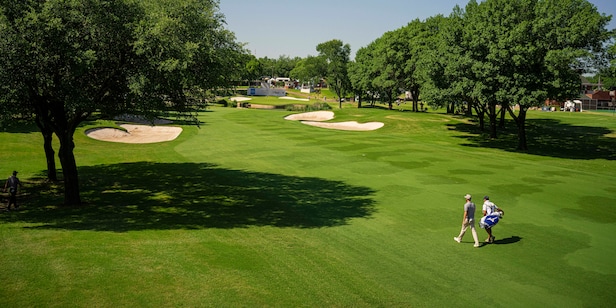On Thursday morning March 12, blue skies shone without a breath of wind at TPC Sawgrass in Ponte Vedra Beach. All businesses and schools throughout surrounding St. Johns County were open.
Andy Levinson, senior vice president of tournament administration for the PGA Tour, sat comfortably at an information booth in a hospitality tent. It was an annual tradition for he and Andy Pazder, chief of tournaments and competition, to work a shift together as ambassadors to kick off the Players Championship. Tour brass directing fans on the best routes to the 17th green or the restroom had something of the cheerful air of the queen volunteering at a soup kitchen. “It was always one of the most fun days of the year,” Levinson says. “I’m there by myself wondering where Andy is, and soon my phone starts going crazy.”
Watch the video below—as we detail how golf saved its season:
Part of that craziness involved the critical tweets of several players, the sharpest from Lucas Glover, about what he and others viewed as an inadequate response to the country’s dawning awareness of a deadly pandemic. To start the week, the ATP Tour had canceled its tennis tournament in California. The NBA had postponed its season the night before. That morning, MLS announced it was postponing, followed by the NHL. College sporting events were dropping by the minute. But the PGA Tour was proceeding as normal, and only without fans starting Friday. In an act of prescience, golfer C.T. Pan withdrew immediately and flew home to Houston.
The tour had known about the virus since the national health emergency was declared in January. The week before the Players, at the Arnold Palmer Invitational in Orlando, there had been zero communication to golfers on the topic. “No one was the wiser; none of this was expected,” says Anirban Lahiri, who had missed that cut and flown home for the India Open, not knowing he was about to go 73 days without hitting a golf ball. Lahiri got updates on these first fraught moments at the Players from afar. Levinson, whose foray into medicine had never gone further than drug-testing players for banned substances, had no idea that educating himself on the facts of the virus would fall on him so squarely that he would acquire the nickname “Doc” Levinson.
Levinson stuck out his shift at the hospitality tent until late morning, then bolted to the second-floor boardroom of the clubhouse to join PGA Tour commissioner Jay Monahan, Pazder and others in a revolving meeting that would last until 9:30 that night. Levinson began working the phones of physicians with the tour’s medical advisor, Dr. Tom Hospel. There were less than a handful of known cases in Florida, so they received mostly general information about infectious diseases. (Hospel is something of a superhuman who would attend the first 10 events of the tour’s restart, all while maintaining his medical practice in Dublin, Ohio, and serving as a consultant to the NBA and a pro soccer team during the pandemic.)
Tyler Dennis, PGA Tour senior vice president and chief of operations, led an emergency meeting to draft a plan for, at least, the next day. The tour had a precedent of single rounds without spectators after severely damaging storms, but this was new. To limit the number of people on property meant thinking through the player’s experience from arrival to departure. Dennis’ young son was set to be a standard bearer, but of course, with no fans to see players’ scores, that was out, as were marshals, most security, hospitality workers and more. The event still needed security at the gates, ShotLink laser spotters for the broadcast, range pickers and some food service. In a few hours, 2,000 volunteers were culled to less than 400.
“Remarkably, the plan we came up with that afternoon ended up being pretty similar to what we used all year,” Dennis says.
As tour executives scrambled to think through options, players demonstrated their uncanny ability to focus amid distraction. With conditions benign, they ripped TPC Sawgrass apart. “It was just business as usual—go out there, go to work. I didn’t really think much about it,” said Patrick Cantlay, who shot 67 playing with Hideki Matsuyama, whose 63 tied the course record even with a wet bogey on the par-5 16th. If a golfer had skipped the news and locker-room small talk, the news found him. People in the gallery made comments. Leader boards flashed the notice about no fans the next day. “At one point, I was nearly expecting the horns to go off and for us all to be taken off,” said Graeme McDowell after a 68. Foreshadowing the divide about to grip the country, some fans vacated quickly while others stayed in the spirit of making the most of it while they could.
Late that afternoon, as Justin Rose and Cheyenne Woods mingled out of obligation with clients of a financial firm, Tracy West, the tournament director for the following week’s Valspar Championship, received a call from the tour. (The Tampa Bay event has the unfortunate distinction of twice being canceled. It occupied the date on the schedule after September 11, 2001.) West was also the tournament’s director in 2001 and had that experience to lean on when she was asked to develop, rapidly, a new safety plan from scratch. She and her staff spent five manic hours calling health officials and hospitals and doing things like drafting alternative bussing procedures. At 9 p.m., everyone was fried, and she told them to go home.
Even in a normal year, the Players is a week of increased dialogue among golfers and the people who work at the organization’s headquarters. “There was a sentiment from many players, but not all, that we should soldier on, show people we can play PGA Tour golf safely, be a beacon,” Pazder says. “But then within 24 hours the pendulum swung the other way in the view of most players that we needed to do the responsible thing and stop play. It was a really fascinating stretch of time.” When Disney World, just a two-hour drive to the south, announced closure of its theme parks, a bell was rung.
The country was shutting down, and the stock market had plummeted. Monahan looked around a boardroom of successful professionals from legal, broadcast and business backgrounds, and no one had an answer. A mixture of rumors and news was beginning to circulate about various countries imposing travel bans, which had the potential to affect nearly two dozen golfers in the field.
“The [weather] forecast was perfect. We had talked to the governor and the mayor. Since we had eliminated fans, I still felt confident we could execute the event,” Monahan remembers. Toward the end of the evening, Laura Neal, senior vice president of communications, said to the room, “What would a reasonable person expect us to do?”

